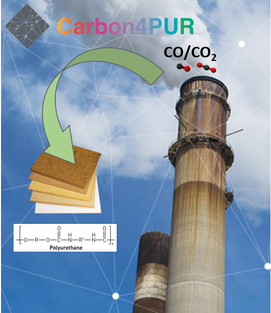Leadership in enabling and industrial technologies - SPIRE - Carbon4PUR
H2020 LEIT SPIRE

The EU process industry needs to become less dependent on fossils as a source of carbon, and – at the same time - reduce the greenhouse effect by decarbonizing the economy. Carbon4PUR will tackle the two challenges at the same time by transforming the CO/CO2 containing flue gas streams of the energy-intensive steel industry into higher value intermediates for market-oriented consumer products.
Both the consortium and the work are organized along the full value chain starting with the provision and conditioning of industrial emissions from a steel to a chemical company in line with the concept of industrial symbiosis, going through the transformation into chemical building blocks – lactones and cyclic carbonates – which both will be further transformed into polymer intermediates and flow into desired sustainable polyurethane applications of rigid foams and coatings. LCA and technology evaluation will be performed and replication strategies, to transfer the technology to other applications, will be elaborated. The distinctive feature of the developed process is avoiding resource-intense separation of the gas components before the synthesis, and developing a chemo-catalytic process to deal directly with the gas mixture instead. The challenge and innovation is coming up with an adjustable process in terms of on-purpose and demand tailor-made production of required products, taking into account all variables at the same time: the available flue gases characteristic from the steel plant, material and process parameters, and the market requirements for the end product.
Objectives
The unique Carbon4PUR technology will valorize steel off-gases without previous cleaning or separation of the gas components.
- Reduce the greenhouse effect by decarbonizing the economy (reduction of the CO2 footprint of polyurethane production by 20-60%)
- Transform CO/CO2 containing waste flue gas streams of the energy-intensive steel industry into higher value intermediates for market-oriented consumer products (substitution of at least 15% of the oil-based reactants by waste-gas based carbon)
Role of Ghent University
Conditioning of Secondary Raw Material Waste Streams
- Selectively remove H2 from an industrial CO/CO2 rich waste stream
- Develop H2 removal catalysts/materials via a single step catalytic methanation process or a two-step chemical looping process
- Investigate the quality of the mixed gas streams using samples of the flue gases for trials at Ghent University
- Develop a catalytic procedure on how to remove H2 from the CO/CO2 rich flue gases from Arcelor Mittal
Contact
Prof. dr. Mark Saeys
Materials, Textiles and Chemical Engineering
Phone number: +3293311754
E-mail: mark.saeys@ugent.be